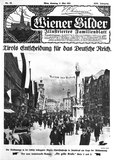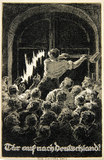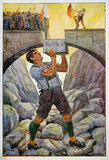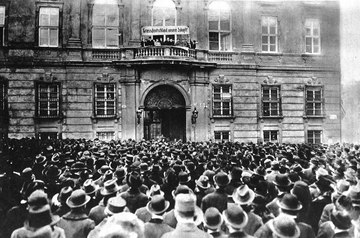Austrian attempts to unite with Germany from the founding of the republic to the referendums in Tyrol and Salzburg in 1921
-

“Tirol's chooses the German Reich”, title page of Wiener Bilder, issue of 8 May 1921
Copyright: ÖNB/ANNO
Partner: Austrian National Library -

“Open the gates to Germany!”, postcard on the unification of Austria with Germany, published by the Pan-German Federation, Graz, 1918
Copyright: Schloß Schönbrunn Kultur- und Betriebsges.m.b.H. / Objekt aus der Sammlung Dr. Lukan
-

“Anschluss”, propaganda postcard for the unification of Austria with Germany, published by Göth, Vienna and Munich, 1921
Copyright: Schloß Schönbrunn Kultur- und Betriebsges.m.b.H. / Objekt aus der Sammlung Dr. Lukan
On 12 November 1918 the Provisional National Assembly of German-Austria proclaimed the Republic and declared its union with Germany. Article 2 of the provisional constitution stated that ‘German-Austria is an integral part of the German Republic.’
The union of the two countries was meant to counter the economic, political and national difficulties with which the new republic saw itself confronted after the end of the war and the collapse of the Habsburg Empire. The Grossdeutsche Partei (Pan-German Party) and the Landbund (Country Alliance) advocated the union for ideological reasons, their argument being based on the common cultural heritage, the common language and nationality. The Social Democrats, particularly Otto Bauer, also advocated joining the German Republic, which was more highly industrialized than the Austrian territories and thus had a larger Social Democrat base. Together with these arguments derived from political strategy, it was above all economic considerations that predominated. Among the Christian Socialists, who had initially hoped for the restoration of the Habsburgs, there was markedly less support for the attempts at a union.
The German side reacted positively to the resolution passed by the National Assembly of German-Austria. In November 1918 the German government announced the incorporation of German-Austria, which was later confirmed by Article 61 of the constitution of the Weimar Republic.
However, hopes of union were dashed by the treaties of Saint-Germain (for Austria) and Versailles (for Germany). The former stipulated that Austrian independence was ‘irrevocable’ and required the name ‘German-Austria’ to be changed to ‘Republic of Austria’. Germany also had to bow to pressure from the Allies and delete the article of the constitution mentioned above. The aim of the victorious powers was to prevent any strengthening of the political power of Germany and Austria, who had to bear the burden of war guilt. Nevertheless, the explicit ban on any union was not able to eradicate completely the idea of it, which remained widespread among the Austrian population.
On 1 October 1920 the Constituent National Assembly passed a motion calling on the government to hold a plebiscite on the union of Austria with Germany. There was a guarded reaction from Germany, because it was due to hold negotiations on loans with the League of Nations and feared that the Allies might terminate their aid programme. Nevertheless, in April and May the provinces of Tyrol and Salzburg each held a referendum on the question, ‘Is union with the German Reich required?’ The result was that an overwhelming majority voted in favour of union. Although the votes did not have any political consequences, they make clear how explosive the issue was among the Austrian population. As a result of the Allies’ threats and the still unconcluded negotiations regarding the borders of Burgenland it was eventually decided that there would be no more referendums, but the idea of union with Germany by no means disappeared from the political debate.
Translation: Leigh Bailey
Bielka, Erich: Die Volksabstimmung in Tirol 1921 und ihre Vorgeschichte, in: Ackerl, Isabella/Neck, Rudolf (Hrsg.): Saint-Germain 1919. Protokoll des Symposiums am 29. und 30. Mai 1979 in Wien, Wien 1989, 303-326
Bielka, Erich: Salzburger Volksabstimmung 1921 – auch manipuliert?, in: Ackerl, Isabella/Neck, Rudolf (Hrsg.): Saint-Germain 1919. Protokoll des Symposiums am 29. und 30. Mai 1979 in Wien, Wien 1989, 327-349
Goldinger, Walter/Binder, Dieter A.: Geschichte der Republik Österreich 1918-1938, München 1992
Graf, Stefan: Was blieb vom alten Österreich?, in: Natter, Tobias G. (Hrsg.): „Kanton Übrig“. Als Vorarlberg zur Schweiz gehören wollte, Bregenz 2008, 10-24
Koch, Alexandra: Die Heimat ruft! Aber welche? Propagandistische Stilmittel nach dem 1. Weltkrieg in Österreich, in: Natter, Tobias G. (Hrsg.): „Kanton Übrig“. Als Vorarlberg zur Schweiz gehören wollte, Bregenz 2008, 54-64
Leidinger, Hannes/Moritz, Verena: Die Republik Österreich 1918/2008. Überblick, Zwischenbilanz, Neubewertung, Wien 2008
Low, Alfred D.: Die Anschlussbewegung in Österreich und Deutschland, 1918-1919 und die Pariser Friedenskonferenz, Wien 1975
Möller, Horst: Europa zwischen den Weltkriegen, München 1998
Möller, Horst: Österreich und seine Nachbarn: Deutschland (1919-1955), in: Koch, Klaus et al. (Hrsg.): Außenpolitische Dokumente der Republik Österreich 1918-1938. Von Saint-Germain zum Belvedere. Österreich und Europa 1919-1955, Wien 2007, 158-171
Rauscher, Walter: Die Republikgründungen 1918 und 1945, in: Koch, Klaus et al. (Hrsg.): Außenpolitische Dokumente der Republik Österreich 1918-1938. Von Saint-Germain zum Belvedere. Österreich und Europa 1919-1955, Wien 2007, 9-24
Suppan, Arnold: Von Saint-Germain zum Belvedere. Österreich und Europa von 1919-1955, in: Koch, Klaus et al. (Hrsg.): Außenpolitische Dokumente der Republik Österreich 1918-1938. Von Saint-Germain zum Belvedere. Österreich und Europa 1919-1955, Wien 2007, 25-43
Vocelka, Karl: Geschichte Österreichs. Kultur – Gesellschaft – Politik, 3. Auflage, Graz/Wien/Köln 2002
Zöllner, Erich: Geschichte Österreichs. Von den Anfängen bis zur Gegenwart, 8. Auflage, Wien/München 1990
Quotes:
"German-Austria is an integral ...“: provisorische Verfassung, quoted from: Möller, Horst: Österreich und seine Nachbarn: Deutschland (1919-1955), in: Koch, Klaus et al. (Hrsg.): Außenpolitische Dokumente der Republik Österreich 1918-1938. Von Saint-Germain zum Belvedere. Österreich und Europa 1919-1955, Wien 2007, 161 (Translation)
-
Chapters
- The High Price of Peace
- Tyrol Is Divided
- Burgenland Is Gained
- The defensive campaign in Carinthia and the plebiscite on 10 October 1920
- Losing Southern Styria
- Fixing the Northern Frontier
- Austrian Federal Province or Swiss Canton?
- Austrian attempts to unite with Germany from the founding of the republic to the referendums in Tyrol and Salzburg in 1921






